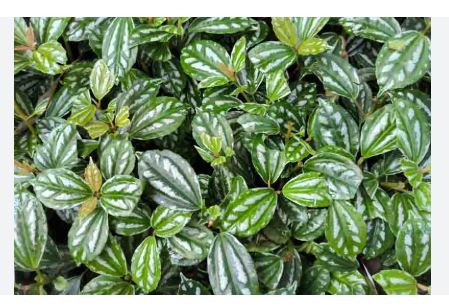
Pilea cadierei, commonly known as the Aluminum Plant or Watermelon Pilea, belongs to the Urticaceae family. It is part of the genus Pilea, which includes numerous species of small herbaceous plants. The specific epithet “cadierei” honors the French botanist Léo Marie Joseph Frédéric Cadière, who specialized in the flora of Indochina. This plant is a perennial herb, which means it can live for more than two years, and it’s noted for its ornamental foliage rather than flowers.
The Aluminum Plant is celebrated for its striking leaves, which are characterized by a quilted texture and silvery markings. The leaves are ovate or elliptic, growing to about 2 to 4 inches long, with a dark green background contrasting sharply against the silver patches, giving it the aluminum-like appearance from which its common name derives. The leaves have a thick, fleshy texture and are arranged oppositely along the stems. Pilea cadierei can grow to a height of approximately 12 to 15 inches. It produces small, inconspicuous flowers that are not the main attraction of this plant; instead, it’s the foliage that captivates. The stems are somewhat succulent, and the plant can develop a bushy habit with proper care.
Pilea cadierei is indigenous to the limestone hills of Vietnam, where it grows in the understory of tropical forests. This habitat explains its preference for high humidity and indirect light conditions, as it’s accustomed to the dappled sunlight through the forest canopy. Its natural environment is warm, with consistent moisture, which informs its indoor care requirements.
The Aluminum Plant was discovered in the early 20th century and was named in honor of Léo Cadière due to his contributions to botany in Southeast Asia. It was introduced to the Western world as an ornamental plant for its unique foliage. Since then, it has become a popular choice among collectors and houseplant enthusiasts for indoor decoration due to its aesthetic appeal and relatively easy care. Over the years, it has been propagated and distributed globally, often as a houseplant or for use in terrariums and vivariums due to its humidity-loving nature.
Pilea cadierei is not frost-tolerant and thrives in warm, humid environments. It is typically grown as an indoor plant in most parts of the world because of this. However, in terms of USDA Hardiness Zones, where it might be grown outdoors in appropriate climates, it would be suitable for zones 11-12. These zones represent the tropical and subtropics where there’s no risk of frost and where temperatures do not generally drop below 50°F (10°C). Even in these zones, Pilea cadierei would prefer shaded or filtered light conditions to prevent leaf burn and to mimic its native habitat. In cooler climates or during winter, it must be kept indoors or in a greenhouse to protect it from cold temperatures. If you’re considering outdoor cultivation in these zones, ensure the plant is placed in a spot that mimics its natural understory habitat, with high humidity and protection from direct, harsh sunlight.
Pilea Cadierei (Aluminum Plant): Characteristics
- Light: Prefers bright, indirect light. Direct sunlight can scorch the leaves, while too little light can lead to leggy growth and loss of the vibrant silver markings.
- Temperature: Thrives in temperatures between 60-75°F (16-24°C). It should be kept away from drafts and cold windows, especially in winter.
- Humidity: High humidity is essential; ideally, aim for 50% or higher. You can achieve this by placing the plant on a tray with pebbles and water or using a humidifier. Misting can help but should be done sparingly to avoid leaf rot.
- Watering: Water when the top inch of soil feels dry. Overwatering can cause root rot, while underwatering leads to crispy leaves. Ensure good drainage to prevent water from sitting at the roots.
- Soil: Use a well-draining, peat-based potting mix. A mix for African violets or a combination of peat, perlite, and pine bark works well to ensure adequate drainage and aeration.
- Fertilization: Feed monthly during the growing season (spring and summer) with a balanced, water-soluble fertilizer at half strength. Reduce feeding in the fall and winter as growth slows.
- Repotting: Repot every 1-2 years or when the plant becomes root-bound. Choose a pot that is slightly larger than the current one to prevent excess moisture retention.
- Pruning: Trim back leggy stems to encourage bushier growth. Remove any yellow or dead leaves to keep the plant healthy and aesthetically pleasing.
- Propagation: Easily propagated by stem cuttings. Cut just below a node, remove lower leaves, and place in water or moist soil until roots develop.
- Pests: Watch for common houseplant pests like spider mites, mealybugs, and scale. If pests appear, isolate the plant and treat with insecticidal soap or neem oil.
- Diseases: Susceptible to fungal issues like root rot if overwatered or if the humidity is too high without good air circulation. Ensure proper watering practices and air flow.
- Growth Habit: Pilea cadierei can become leggy if not provided with enough light. To maintain a compact, bushy form, pinch back the tips occasionally and ensure the plant receives adequate light.